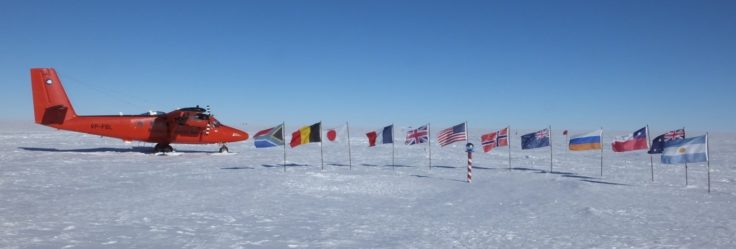Global S&T Development Trend Analysis Platform of Resources and Environment
| Record warming at the South Pole | |
| admin | |
| 2020-06-29 | |
| 发布年 | 2020 |
| 语种 | 英语 |
| 国家 | 英国 |
| 领域 | 资源环境 |
| 正文(英文) | The South Pole has warmed at over three times the global rate since 1989, according to a paper published in Nature Climate Change today (29 June 2020). This warming period was mainly driven by natural tropical climate variability and was likely intensified by increases in greenhouse gases, the authors suggest. The Antarctic climate exhibits some of the largest ranges in temperature over the course of a year, and some of the largest temperature trends on the planet, with strong regional contrasts. Most of West Antarctica and the Antarctic Peninsula experienced warming and ice-sheet thinning during the late twentieth century. By contrast, the South Pole — located in the remote and high-altitude continental interior — cooled until the 1980s, but has since warmed substantially. These trends are affected by natural and anthropogenic climate change, but the individual contribution of each factor is not well understood and challenging to precisely determine.  A team of scientists analysed weather station data, gridded observations and climate model simulations to examine the warming trend at the South Pole. Their study found that the strong warming over the Antarctic interior during the last 30 years was chiefly driven by the tropics, especially warm ocean temperatures in the western tropical Pacific Ocean, which has lowered atmospheric pressure over the Weddell Sea (high-latitude South Atlantic) and increased the delivery of warm air to the South Pole. The authors suggest these atmospheric changes along Antarctica’s coast are an important mechanism driving extreme multi-decadal climate anomalies in its interior.
The authors argue that these warming trends were unlikely the result of natural climate change alone, emphasizing the effects of anthropogenic warming on top of the large tropical climate signal in Antarctic climate have worked in tandem to make this one of the strongest warming trends on Earth.
Record warming at the South Pole during the past three decades by Clem, K., R. L. Fogt, J. Turner, B. R. Lintner, G. Marshall, J. R. Miller, A. J. Broccoli and J. Renwick (2020) is published in the journal Nature Climate Change.
|
| URL | 查看原文 |
| 来源平台 | British Antarctic Survey |
| 文献类型 | 新闻 |
| 条目标识符 | http://119.78.100.173/C666/handle/2XK7JSWQ/278340 |
| 专题 | 资源环境科学 |
| 推荐引用方式 GB/T 7714 | admin. Record warming at the South Pole. 2020. |
| 条目包含的文件 | 条目无相关文件。 | |||||
| 个性服务 |
| 推荐该条目 |
| 保存到收藏夹 |
| 查看访问统计 |
| 导出为Endnote文件 |
| 谷歌学术 |
| 谷歌学术中相似的文章 |
| [admin]的文章 |
| 百度学术 |
| 百度学术中相似的文章 |
| [admin]的文章 |
| 必应学术 |
| 必应学术中相似的文章 |
| [admin]的文章 |
| 相关权益政策 |
| 暂无数据 |
| 收藏/分享 |
除非特别说明,本系统中所有内容都受版权保护,并保留所有权利。
修改评论